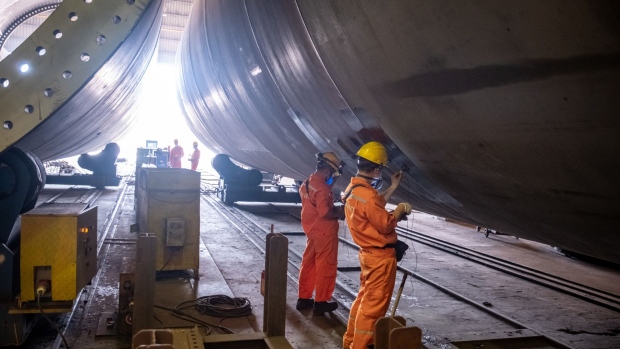Mar 21, 2023
Tycoon Who Made ‘Lucky’ US Wind Power Bet Plans to Invest More
, Bloomberg News

(Bloomberg) -- Gim Seong-gon, who became an early wind-power tycoon after realizing time was running out for his business of building chimneys for fossil fuel plants, was about to make his next surprising move.
It was 2021, and US President Donald Trump had just left office after four years dismissing climate change, calling it an “expensive hoax.” But, undeterred, Gim decided during Trump’s term to expand into the country. That June, his CS Wind Corp. completed its biggest-ever investment, spending $150 million to take over the world’s largest wind-tower manufacturing facility in Colorado.
The next year, President Joe Biden signed into law a sweeping climate and tax bill, one that Gim estimates will give his company a $1.5 billion tax windfall over the next decade.
“I was lucky,” Gim said in a rare interview in Seoul. But “it was clear to me that demand would grow in the US.”
Now, the 69-year-old South Korean entrepreneur is planning to spend a further $600 million over the next five years to double the facility’s capacity. He predicts US demand will more than double during that time, driven by Biden’s legislation. Wind power accounted for more than 40% of total power generation from renewables in the US in 2022, far ahead of solar, according to BloombergNEF. Wind power generated 435 terawatt-hours of electricity in the US in 2022, more than triple the amount in 2012.
“The industry is investing at a time when there are limited wind-tower producers in the US that have mass production capacity, and the long-term demand for wind power is growing faster than we had expected,” said Yoon Cho, an equity research analyst at UBS Securities. “Obviously with large investments, though, we would have to monitor the timing and how it’s being financed.”
Gim has a history of making unexpected moves. He owned a construction firm that also made construction materials and parts, including chimneys for coal and diesel plants, when he placed an early bet on wind power two decades ago. His and his family’s stake in CS Wind rose above $1 billion in 2021, according to the Bloomberg Billionaires Index.
“I could sense fossil fuel assets would soon fade,” Gim recalled from his new office in the South Korean capital’s affluent Gangnam district. “The need to transition was obvious.”
Gim’s move and the wealth it generated show wind power’s increasing importance as the world shifts toward renewable energy. His latest investment plan underscores a belief that the sector has further room to grow.
Read more: Farmer’s Son Becomes Billionaire After Early Bet on Wind Power
CS Wind’s sales reached a record last year, but operating profit fell to the lowest since 2018 as capital expenditure climbed. Gim said he aims to win as much as $1.7 billion in orders this year, up more than 80% from last year.
The businessman started his own construction firm in Saudi Arabia in 1984 with $65,000 that he earned after moving there to work at a building-supplies company. It soon expanded into producing construction materials and parts.
He entered the wind-power business in 2003 and later changed the company’s name to CS Wind. Today, CS Wind has manufacturing sites in seven countries and is a major supplier to global turbine producers such as Vestas Wind Systems A/S, Siemens Energy AG and GE Renewable Energy. Its wind towers — typically tubular structures that host the rotors and nacelle — were used in almost 15% of new wind-power plants globally, excluding China, in 2022.
Renewables will dominate the growth of the world’s electricity supply over the next three years, according to the International Energy Agency, as countries race to get to zero emissions.
CS Wind’s shares have fallen from a high in 2021 on broader Covid-related supply concerns, pushing the value of the family’s stake back below $1 billion. But their shareholding is still worth $914 million, according to the Bloomberg wealth index.
“Nothing in my life was tougher than in my twenties when I tried to make ends meet” by working multiple jobs, Gim said from a room filled with paintings of renowned Korean artists. “When it was really bad, I could only sleep four hours a night.”
--With assistance from Yoojung Lee.
©2023 Bloomberg L.P.






